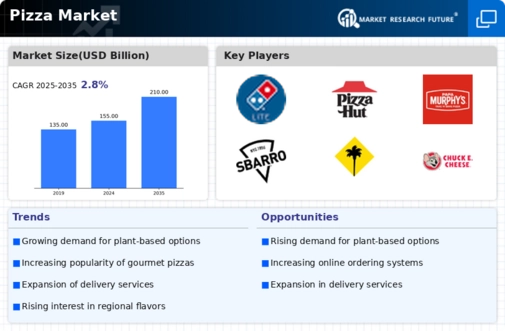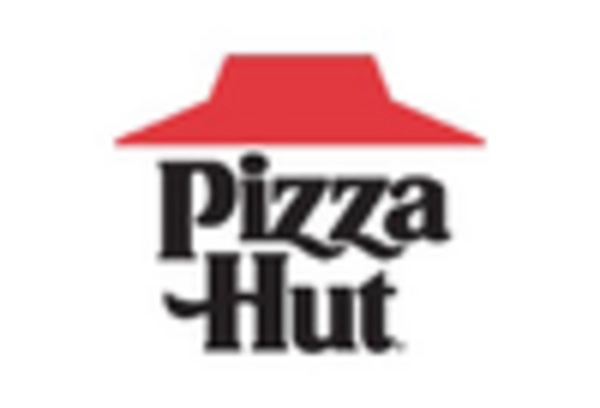-
EXECUTIVE SUMMARY
-
Market Overview
-
Key Findings
-
Market Segmentation
-
Competitive Landscape
-
Challenges and Opportunities
-
Future Outlook
-
MARKET INTRODUCTION
-
Definition
-
Scope of the study
-
Research Objective
-
Assumption
-
Limitations
-
RESEARCH METHODOLOGY
-
Overview
-
Data Mining
-
Secondary Research
-
Primary Research
-
Primary Interviews and Information Gathering Process
-
Breakdown of Primary Respondents
-
Forecasting Model
-
Market Size Estimation
-
Bottom-Up Approach
-
Top-Down Approach
-
Data Triangulation
-
Validation
-
MARKET DYNAMICS
-
Overview
-
Drivers
-
Restraints
-
Opportunities
-
MARKET FACTOR ANALYSIS
-
Value chain Analysis
-
Porter's Five Forces Analysis
-
Bargaining Power of Suppliers
-
Bargaining Power of Buyers
-
Threat of New Entrants
-
Threat of Substitutes
-
Intensity of Rivalry
-
COVID-19 Impact Analysis
-
Market Impact Analysis
-
Regional Impact
-
Opportunity and Threat Analysis
-
Pizza Market, BY Type (USD Billion)
-
Regular Pizza
-
Frozen Pizza
-
Organic Pizza
-
Gluten-Free Pizza
-
Vegan Pizza
-
Pizza Market, BY Crust Type (USD Billion)
-
Thin Crust
-
Thick Crust
-
Stuffed Crust
-
Cauliflower Crust
-
Pizza Market, BY Toppings (USD Billion)
-
Vegetarian
-
Meat Lover's
-
Cheese
-
Seafood
-
Spicy
-
Pizza Market, BY Sales Channel (USD Billion)
-
Online Delivery
-
Takeaway
-
Sit-Down Restaurants
-
Supermarkets
-
Pizza Market, BY Regional (USD Billion)
-
North America
-
US
-
Canada
-
Europe
-
Germany
-
UK
-
France
-
Russia
-
Italy
-
Spain
-
Rest of Europe
-
APAC
-
China
-
India
-
Japan
-
South Korea
-
Malaysia
-
Thailand
-
Indonesia
-
Rest of APAC
-
South America
-
Brazil
-
Mexico
-
Argentina
-
Rest of South America
-
MEA
-
GCC Countries
-
South Africa
-
Rest of MEA
-
Competitive Landscape
-
Overview
-
Competitive Analysis
-
Market share Analysis
-
Major Growth Strategy in the Pizza Market
-
Competitive Benchmarking
-
Leading Players in Terms of Number of Developments in the Pizza Market
-
Key developments and growth strategies
-
New Product Launch/Service Deployment
-
Merger & Acquisitions
-
Joint Ventures
-
Major Players Financial Matrix
-
Sales and Operating Income
-
Major Players R&D Expenditure. 2023
-
Company Profiles
-
Toppers Pizza
-
Financial Overview
-
Products Offered
-
Key Developments
-
SWOT Analysis
-
Key Strategies
-
Round Table Pizza
-
Financial Overview
-
Products Offered
-
Key Developments
-
SWOT Analysis
-
Key Strategies
-
Sbarro
-
Financial Overview
-
Products Offered
-
Key Developments
-
SWOT Analysis
-
Key Strategies
-
Blaze Pizza
-
Financial Overview
-
Products Offered
-
Key Developments
-
SWOT Analysis
-
Key Strategies
-
Piezoni's
-
Financial Overview
-
Products Offered
-
Key Developments
-
SWOT Analysis
-
Key Strategies
-
Hungry Howie's
-
Financial Overview
-
Products Offered
-
Key Developments
-
SWOT Analysis
-
Key Strategies
-
Marco's Pizza
-
Financial Overview
-
Products Offered
-
Key Developments
-
SWOT Analysis
-
Key Strategies
-
Little Caesars
-
Financial Overview
-
Products Offered
-
Key Developments
-
SWOT Analysis
-
Key Strategies
-
Papa Murphy's
-
Financial Overview
-
Products Offered
-
Key Developments
-
SWOT Analysis
-
Key Strategies
-
Pizza Hut
-
Financial Overview
-
Products Offered
-
Key Developments
-
SWOT Analysis
-
Key Strategies
-
Domino's Pizza
-
Financial Overview
-
Products Offered
-
Key Developments
-
SWOT Analysis
-
Key Strategies
-
Papa John's
-
Financial Overview
-
Products Offered
-
Key Developments
-
SWOT Analysis
-
Key Strategies
-
California Pizza Kitchen
-
Financial Overview
-
Products Offered
-
Key Developments
-
SWOT Analysis
-
Key Strategies
-
Donatos Pizza
-
Financial Overview
-
Products Offered
-
Key Developments
-
SWOT Analysis
-
Key Strategies
-
Jet's Pizza
-
Financial Overview
-
Products Offered
-
Key Developments
-
SWOT Analysis
-
Key Strategies
-
Appendix
-
References
-
Related Reports
-
LIST Of tables
-
LIST OF ASSUMPTIONS
-
North America Pizza Market SIZE ESTIMATES & FORECAST, BY TYPE, 2019-2035 (USD Billions)
-
North America Pizza Market SIZE ESTIMATES & FORECAST, BY CRUST TYPE, 2019-2035 (USD Billions)
-
North America Pizza Market SIZE ESTIMATES & FORECAST, BY TOPPINGS, 2019-2035 (USD Billions)
-
North America Pizza Market SIZE ESTIMATES & FORECAST, BY SALES CHANNEL, 2019-2035 (USD Billions)
-
North America Pizza Market SIZE ESTIMATES & FORECAST, BY REGIONAL, 2019-2035 (USD Billions)
-
US Pizza Market SIZE ESTIMATES & FORECAST, BY TYPE, 2019-2035 (USD Billions)
-
US Pizza Market SIZE ESTIMATES & FORECAST, BY CRUST TYPE, 2019-2035 (USD Billions)
-
US Pizza Market SIZE ESTIMATES & FORECAST, BY TOPPINGS, 2019-2035 (USD Billions)
-
US Pizza Market SIZE ESTIMATES & FORECAST, BY SALES CHANNEL, 2019-2035 (USD Billions)
-
US Pizza Market SIZE ESTIMATES & FORECAST, BY REGIONAL, 2019-2035 (USD Billions)
-
Canada Pizza Market SIZE ESTIMATES & FORECAST, BY TYPE, 2019-2035 (USD Billions)
-
Canada Pizza Market SIZE ESTIMATES & FORECAST, BY CRUST TYPE, 2019-2035 (USD Billions)
-
Canada Pizza Market SIZE ESTIMATES & FORECAST, BY TOPPINGS, 2019-2035 (USD Billions)
-
Canada Pizza Market SIZE ESTIMATES & FORECAST, BY SALES CHANNEL, 2019-2035 (USD Billions)
-
Canada Pizza Market SIZE ESTIMATES & FORECAST, BY REGIONAL, 2019-2035 (USD Billions)
-
Europe Pizza Market SIZE ESTIMATES & FORECAST, BY TYPE, 2019-2035 (USD Billions)
-
Europe Pizza Market SIZE ESTIMATES & FORECAST, BY CRUST TYPE, 2019-2035 (USD Billions)
-
Europe Pizza Market SIZE ESTIMATES & FORECAST, BY TOPPINGS, 2019-2035 (USD Billions)
-
Europe Pizza Market SIZE ESTIMATES & FORECAST, BY SALES CHANNEL, 2019-2035 (USD Billions)
-
Europe Pizza Market SIZE ESTIMATES & FORECAST, BY REGIONAL, 2019-2035 (USD Billions)
-
Germany Pizza Market SIZE ESTIMATES & FORECAST, BY TYPE, 2019-2035 (USD Billions)
-
Germany Pizza Market SIZE ESTIMATES & FORECAST, BY CRUST TYPE, 2019-2035 (USD Billions)
-
Germany Pizza Market SIZE ESTIMATES & FORECAST, BY TOPPINGS, 2019-2035 (USD Billions)
-
Germany Pizza Market SIZE ESTIMATES & FORECAST, BY SALES CHANNEL, 2019-2035 (USD Billions)
-
Germany Pizza Market SIZE ESTIMATES & FORECAST, BY REGIONAL, 2019-2035 (USD Billions)
-
UK Pizza Market SIZE ESTIMATES & FORECAST, BY TYPE, 2019-2035 (USD Billions)
-
UK Pizza Market SIZE ESTIMATES & FORECAST, BY CRUST TYPE, 2019-2035 (USD Billions)
-
UK Pizza Market SIZE ESTIMATES & FORECAST, BY TOPPINGS, 2019-2035 (USD Billions)
-
UK Pizza Market SIZE ESTIMATES & FORECAST, BY SALES CHANNEL, 2019-2035 (USD Billions)
-
UK Pizza Market SIZE ESTIMATES & FORECAST, BY REGIONAL, 2019-2035 (USD Billions)
-
France Pizza Market SIZE ESTIMATES & FORECAST, BY TYPE, 2019-2035 (USD Billions)
-
France Pizza Market SIZE ESTIMATES & FORECAST, BY CRUST TYPE, 2019-2035 (USD Billions)
-
France Pizza Market SIZE ESTIMATES & FORECAST, BY TOPPINGS, 2019-2035 (USD Billions)
-
France Pizza Market SIZE ESTIMATES & FORECAST, BY SALES CHANNEL, 2019-2035 (USD Billions)
-
France Pizza Market SIZE ESTIMATES & FORECAST, BY REGIONAL, 2019-2035 (USD Billions)
-
Russia Pizza Market SIZE ESTIMATES & FORECAST, BY TYPE, 2019-2035 (USD Billions)
-
Russia Pizza Market SIZE ESTIMATES & FORECAST, BY CRUST TYPE, 2019-2035 (USD Billions)
-
Russia Pizza Market SIZE ESTIMATES & FORECAST, BY TOPPINGS, 2019-2035 (USD Billions)
-
Russia Pizza Market SIZE ESTIMATES & FORECAST, BY SALES CHANNEL, 2019-2035 (USD Billions)
-
Russia Pizza Market SIZE ESTIMATES & FORECAST, BY REGIONAL, 2019-2035 (USD Billions)
-
Italy Pizza Market SIZE ESTIMATES & FORECAST, BY TYPE, 2019-2035 (USD Billions)
-
Italy Pizza Market SIZE ESTIMATES & FORECAST, BY CRUST TYPE, 2019-2035 (USD Billions)
-
Italy Pizza Market SIZE ESTIMATES & FORECAST, BY TOPPINGS, 2019-2035 (USD Billions)
-
Italy Pizza Market SIZE ESTIMATES & FORECAST, BY SALES CHANNEL, 2019-2035 (USD Billions)
-
Italy Pizza Market SIZE ESTIMATES & FORECAST, BY REGIONAL, 2019-2035 (USD Billions)
-
Spain Pizza Market SIZE ESTIMATES & FORECAST, BY TYPE, 2019-2035 (USD Billions)
-
Spain Pizza Market SIZE ESTIMATES & FORECAST, BY CRUST TYPE, 2019-2035 (USD Billions)
-
Spain Pizza Market SIZE ESTIMATES & FORECAST, BY TOPPINGS, 2019-2035 (USD Billions)
-
Spain Pizza Market SIZE ESTIMATES & FORECAST, BY SALES CHANNEL, 2019-2035 (USD Billions)
-
Spain Pizza Market SIZE ESTIMATES & FORECAST, BY REGIONAL, 2019-2035 (USD Billions)
-
Rest of Europe Pizza Market SIZE ESTIMATES & FORECAST, BY TYPE, 2019-2035 (USD Billions)
-
Rest of Europe Pizza Market SIZE ESTIMATES & FORECAST, BY CRUST TYPE, 2019-2035 (USD Billions)
-
Rest of Europe Pizza Market SIZE ESTIMATES & FORECAST, BY TOPPINGS, 2019-2035 (USD Billions)
-
Rest of Europe Pizza Market SIZE ESTIMATES & FORECAST, BY SALES CHANNEL, 2019-2035 (USD Billions)
-
Rest of Europe Pizza Market SIZE ESTIMATES & FORECAST, BY REGIONAL, 2019-2035 (USD Billions)
-
APAC Pizza Market SIZE ESTIMATES & FORECAST, BY TYPE, 2019-2035 (USD Billions)
-
APAC Pizza Market SIZE ESTIMATES & FORECAST, BY CRUST TYPE, 2019-2035 (USD Billions)
-
APAC Pizza Market SIZE ESTIMATES & FORECAST, BY TOPPINGS, 2019-2035 (USD Billions)
-
APAC Pizza Market SIZE ESTIMATES & FORECAST, BY SALES CHANNEL, 2019-2035 (USD Billions)
-
APAC Pizza Market SIZE ESTIMATES & FORECAST, BY REGIONAL, 2019-2035 (USD Billions)
-
China Pizza Market SIZE ESTIMATES & FORECAST, BY TYPE, 2019-2035 (USD Billions)
-
China Pizza Market SIZE ESTIMATES & FORECAST, BY CRUST TYPE, 2019-2035 (USD Billions)
-
China Pizza Market SIZE ESTIMATES & FORECAST, BY TOPPINGS, 2019-2035 (USD Billions)
-
China Pizza Market SIZE ESTIMATES & FORECAST, BY SALES CHANNEL, 2019-2035 (USD Billions)
-
China Pizza Market SIZE ESTIMATES & FORECAST, BY REGIONAL, 2019-2035 (USD Billions)
-
India Pizza Market SIZE ESTIMATES & FORECAST, BY TYPE, 2019-2035 (USD Billions)
-
India Pizza Market SIZE ESTIMATES & FORECAST, BY CRUST TYPE, 2019-2035 (USD Billions)
-
India Pizza Market SIZE ESTIMATES & FORECAST, BY TOPPINGS, 2019-2035 (USD Billions)
-
India Pizza Market SIZE ESTIMATES & FORECAST, BY SALES CHANNEL, 2019-2035 (USD Billions)
-
India Pizza Market SIZE ESTIMATES & FORECAST, BY REGIONAL, 2019-2035 (USD Billions)
-
Japan Pizza Market SIZE ESTIMATES & FORECAST, BY TYPE, 2019-2035 (USD Billions)
-
Japan Pizza Market SIZE ESTIMATES & FORECAST, BY CRUST TYPE, 2019-2035 (USD Billions)
-
Japan Pizza Market SIZE ESTIMATES & FORECAST, BY TOPPINGS, 2019-2035 (USD Billions)
-
Japan Pizza Market SIZE ESTIMATES & FORECAST, BY SALES CHANNEL, 2019-2035 (USD Billions)
-
Japan Pizza Market SIZE ESTIMATES & FORECAST, BY REGIONAL, 2019-2035 (USD Billions)
-
South Korea Pizza Market SIZE ESTIMATES & FORECAST, BY TYPE, 2019-2035 (USD Billions)
-
South Korea Pizza Market SIZE ESTIMATES & FORECAST, BY CRUST TYPE, 2019-2035 (USD Billions)
-
South Korea Pizza Market SIZE ESTIMATES & FORECAST, BY TOPPINGS, 2019-2035 (USD Billions)
-
South Korea Pizza Market SIZE ESTIMATES & FORECAST, BY SALES CHANNEL, 2019-2035 (USD Billions)
-
South Korea Pizza Market SIZE ESTIMATES & FORECAST, BY REGIONAL, 2019-2035 (USD Billions)
-
Malaysia Pizza Market SIZE ESTIMATES & FORECAST, BY TYPE, 2019-2035 (USD Billions)
-
Malaysia Pizza Market SIZE ESTIMATES & FORECAST, BY CRUST TYPE, 2019-2035 (USD Billions)
-
Malaysia Pizza Market SIZE ESTIMATES & FORECAST, BY TOPPINGS, 2019-2035 (USD Billions)
-
Malaysia Pizza Market SIZE ESTIMATES & FORECAST, BY SALES CHANNEL, 2019-2035 (USD Billions)
-
Malaysia Pizza Market SIZE ESTIMATES & FORECAST, BY REGIONAL, 2019-2035 (USD Billions)
-
Thailand Pizza Market SIZE ESTIMATES & FORECAST, BY TYPE, 2019-2035 (USD Billions)
-
Thailand Pizza Market SIZE ESTIMATES & FORECAST, BY CRUST TYPE, 2019-2035 (USD Billions)
-
Thailand Pizza Market SIZE ESTIMATES & FORECAST, BY TOPPINGS, 2019-2035 (USD Billions)
-
Thailand Pizza Market SIZE ESTIMATES & FORECAST, BY SALES CHANNEL, 2019-2035 (USD Billions)
-
Thailand Pizza Market SIZE ESTIMATES & FORECAST, BY REGIONAL, 2019-2035 (USD Billions)
-
Indonesia Pizza Market SIZE ESTIMATES & FORECAST, BY TYPE, 2019-2035 (USD Billions)
-
Indonesia Pizza Market SIZE ESTIMATES & FORECAST, BY CRUST TYPE, 2019-2035 (USD Billions)
-
Indonesia Pizza Market SIZE ESTIMATES & FORECAST, BY TOPPINGS, 2019-2035 (USD Billions)
-
Indonesia Pizza Market SIZE ESTIMATES & FORECAST, BY SALES CHANNEL, 2019-2035 (USD Billions)
-
Indonesia Pizza Market SIZE ESTIMATES & FORECAST, BY REGIONAL, 2019-2035 (USD Billions)
-
Rest of APAC Pizza Market SIZE ESTIMATES & FORECAST, BY TYPE, 2019-2035 (USD Billions)
-
Rest of APAC Pizza Market SIZE ESTIMATES & FORECAST, BY CRUST TYPE, 2019-2035 (USD Billions)
-
Rest of APAC Pizza Market SIZE ESTIMATES & FORECAST, BY TOPPINGS, 2019-2035 (USD Billions)
-
Rest of APAC Pizza Market SIZE ESTIMATES & FORECAST, BY SALES CHANNEL, 2019-2035 (USD Billions)
-
Rest of APAC Pizza Market SIZE ESTIMATES & FORECAST, BY REGIONAL, 2019-2035 (USD Billions)
-
South America Pizza Market SIZE ESTIMATES & FORECAST, BY TYPE, 2019-2035 (USD Billions)
-
South America Pizza Market SIZE ESTIMATES & FORECAST, BY CRUST TYPE, 2019-2035 (USD Billions)
-
South America Pizza Market SIZE ESTIMATES & FORECAST, BY TOPPINGS, 2019-2035 (USD Billions)
-
South America Pizza Market SIZE ESTIMATES & FORECAST, BY SALES CHANNEL, 2019-2035 (USD Billions)
-
South America Pizza Market SIZE ESTIMATES & FORECAST, BY REGIONAL, 2019-2035 (USD Billions)
-
Brazil Pizza Market SIZE ESTIMATES & FORECAST, BY TYPE, 2019-2035 (USD Billions)
-
Brazil Pizza Market SIZE ESTIMATES & FORECAST, BY CRUST TYPE, 2019-2035 (USD Billions)
-
Brazil Pizza Market SIZE ESTIMATES & FORECAST, BY TOPPINGS, 2019-2035 (USD Billions)
-
Brazil Pizza Market SIZE ESTIMATES & FORECAST, BY SALES CHANNEL, 2019-2035 (USD Billions)
-
Brazil Pizza Market SIZE ESTIMATES & FORECAST, BY REGIONAL, 2019-2035 (USD Billions)
-
Mexico Pizza Market SIZE ESTIMATES & FORECAST, BY TYPE, 2019-2035 (USD Billions)
-
Mexico Pizza Market SIZE ESTIMATES & FORECAST, BY CRUST TYPE, 2019-2035 (USD Billions)
-
Mexico Pizza Market SIZE ESTIMATES & FORECAST, BY TOPPINGS, 2019-2035 (USD Billions)
-
Mexico Pizza Market SIZE ESTIMATES & FORECAST, BY SALES CHANNEL, 2019-2035 (USD Billions)
-
Mexico Pizza Market SIZE ESTIMATES & FORECAST, BY REGIONAL, 2019-2035 (USD Billions)
-
Argentina Pizza Market SIZE ESTIMATES & FORECAST, BY TYPE, 2019-2035 (USD Billions)
-
Argentina Pizza Market SIZE ESTIMATES & FORECAST, BY CRUST TYPE, 2019-2035 (USD Billions)
-
Argentina Pizza Market SIZE ESTIMATES & FORECAST, BY TOPPINGS, 2019-2035 (USD Billions)
-
Argentina Pizza Market SIZE ESTIMATES & FORECAST, BY SALES CHANNEL, 2019-2035 (USD Billions)
-
Argentina Pizza Market SIZE ESTIMATES & FORECAST, BY REGIONAL, 2019-2035 (USD Billions)
-
Rest of South America Pizza Market SIZE ESTIMATES & FORECAST, BY TYPE, 2019-2035 (USD Billions)
-
Rest of South America Pizza Market SIZE ESTIMATES & FORECAST, BY CRUST TYPE, 2019-2035 (USD Billions)
-
Rest of South America Pizza Market SIZE ESTIMATES & FORECAST, BY TOPPINGS, 2019-2035 (USD Billions)
-
Rest of South America Pizza Market SIZE ESTIMATES & FORECAST, BY SALES CHANNEL, 2019-2035 (USD Billions)
-
Rest of South America Pizza Market SIZE ESTIMATES & FORECAST, BY REGIONAL, 2019-2035 (USD Billions)
-
MEA Pizza Market SIZE ESTIMATES & FORECAST, BY TYPE, 2019-2035 (USD Billions)
-
MEA Pizza Market SIZE ESTIMATES & FORECAST, BY CRUST TYPE, 2019-2035 (USD Billions)
-
MEA Pizza Market SIZE ESTIMATES & FORECAST, BY TOPPINGS, 2019-2035 (USD Billions)
-
MEA Pizza Market SIZE ESTIMATES & FORECAST, BY SALES CHANNEL, 2019-2035 (USD Billions)
-
MEA Pizza Market SIZE ESTIMATES & FORECAST, BY REGIONAL, 2019-2035 (USD Billions)
-
GCC Countries Pizza Market SIZE ESTIMATES & FORECAST, BY TYPE, 2019-2035 (USD Billions)
-
GCC Countries Pizza Market SIZE ESTIMATES & FORECAST, BY CRUST TYPE, 2019-2035 (USD Billions)
-
GCC Countries Pizza Market SIZE ESTIMATES & FORECAST, BY TOPPINGS, 2019-2035 (USD Billions)
-
GCC Countries Pizza Market SIZE ESTIMATES & FORECAST, BY SALES CHANNEL, 2019-2035 (USD Billions)
-
GCC Countries Pizza Market SIZE ESTIMATES & FORECAST, BY REGIONAL, 2019-2035 (USD Billions)
-
South Africa Pizza Market SIZE ESTIMATES & FORECAST, BY TYPE, 2019-2035 (USD Billions)
-
South Africa Pizza Market SIZE ESTIMATES & FORECAST, BY CRUST TYPE, 2019-2035 (USD Billions)
-
South Africa Pizza Market SIZE ESTIMATES & FORECAST, BY TOPPINGS, 2019-2035 (USD Billions)
-
South Africa Pizza Market SIZE ESTIMATES & FORECAST, BY SALES CHANNEL, 2019-2035 (USD Billions)
-
South Africa Pizza Market SIZE ESTIMATES & FORECAST, BY REGIONAL, 2019-2035 (USD Billions)
-
Rest of MEA Pizza Market SIZE ESTIMATES & FORECAST, BY TYPE, 2019-2035 (USD Billions)
-
Rest of MEA Pizza Market SIZE ESTIMATES & FORECAST, BY CRUST TYPE, 2019-2035 (USD Billions)
-
Rest of MEA Pizza Market SIZE ESTIMATES & FORECAST, BY TOPPINGS, 2019-2035 (USD Billions)
-
Rest of MEA Pizza Market SIZE ESTIMATES & FORECAST, BY SALES CHANNEL, 2019-2035 (USD Billions)
-
Rest of MEA Pizza Market SIZE ESTIMATES & FORECAST, BY REGIONAL, 2019-2035 (USD Billions)
-
PRODUCT LAUNCH/PRODUCT DEVELOPMENT/APPROVAL
-
ACQUISITION/PARTNERSHIP
-
LIST Of figures
-
MARKET SYNOPSIS
-
NORTH AMERICA PIZZA MARKET ANALYSIS
-
US PIZZA MARKET ANALYSIS BY TYPE
-
US PIZZA MARKET ANALYSIS BY CRUST TYPE
-
US PIZZA MARKET ANALYSIS BY TOPPINGS
-
US PIZZA MARKET ANALYSIS BY SALES CHANNEL
-
US PIZZA MARKET ANALYSIS BY REGIONAL
-
CANADA PIZZA MARKET ANALYSIS BY TYPE
-
CANADA PIZZA MARKET ANALYSIS BY CRUST TYPE
-
CANADA PIZZA MARKET ANALYSIS BY TOPPINGS
-
CANADA PIZZA MARKET ANALYSIS BY SALES CHANNEL
-
CANADA PIZZA MARKET ANALYSIS BY REGIONAL
-
EUROPE PIZZA MARKET ANALYSIS
-
GERMANY PIZZA MARKET ANALYSIS BY TYPE
-
GERMANY PIZZA MARKET ANALYSIS BY CRUST TYPE
-
GERMANY PIZZA MARKET ANALYSIS BY TOPPINGS
-
GERMANY PIZZA MARKET ANALYSIS BY SALES CHANNEL
-
GERMANY PIZZA MARKET ANALYSIS BY REGIONAL
-
UK PIZZA MARKET ANALYSIS BY TYPE
-
UK PIZZA MARKET ANALYSIS BY CRUST TYPE
-
UK PIZZA MARKET ANALYSIS BY TOPPINGS
-
UK PIZZA MARKET ANALYSIS BY SALES CHANNEL
-
UK PIZZA MARKET ANALYSIS BY REGIONAL
-
FRANCE PIZZA MARKET ANALYSIS BY TYPE
-
FRANCE PIZZA MARKET ANALYSIS BY CRUST TYPE
-
FRANCE PIZZA MARKET ANALYSIS BY TOPPINGS
-
FRANCE PIZZA MARKET ANALYSIS BY SALES CHANNEL
-
FRANCE PIZZA MARKET ANALYSIS BY REGIONAL
-
RUSSIA PIZZA MARKET ANALYSIS BY TYPE
-
RUSSIA PIZZA MARKET ANALYSIS BY CRUST TYPE
-
RUSSIA PIZZA MARKET ANALYSIS BY TOPPINGS
-
RUSSIA PIZZA MARKET ANALYSIS BY SALES CHANNEL
-
RUSSIA PIZZA MARKET ANALYSIS BY REGIONAL
-
ITALY PIZZA MARKET ANALYSIS BY TYPE
-
ITALY PIZZA MARKET ANALYSIS BY CRUST TYPE
-
ITALY PIZZA MARKET ANALYSIS BY TOPPINGS
-
ITALY PIZZA MARKET ANALYSIS BY SALES CHANNEL
-
ITALY PIZZA MARKET ANALYSIS BY REGIONAL
-
SPAIN PIZZA MARKET ANALYSIS BY TYPE
-
SPAIN PIZZA MARKET ANALYSIS BY CRUST TYPE
-
SPAIN PIZZA MARKET ANALYSIS BY TOPPINGS
-
SPAIN PIZZA MARKET ANALYSIS BY SALES CHANNEL
-
SPAIN PIZZA MARKET ANALYSIS BY REGIONAL
-
REST OF EUROPE PIZZA MARKET ANALYSIS BY TYPE
-
REST OF EUROPE PIZZA MARKET ANALYSIS BY CRUST TYPE
-
REST OF EUROPE PIZZA MARKET ANALYSIS BY TOPPINGS
-
REST OF EUROPE PIZZA MARKET ANALYSIS BY SALES CHANNEL
-
REST OF EUROPE PIZZA MARKET ANALYSIS BY REGIONAL
-
APAC PIZZA MARKET ANALYSIS
-
CHINA PIZZA MARKET ANALYSIS BY TYPE
-
CHINA PIZZA MARKET ANALYSIS BY CRUST TYPE
-
CHINA PIZZA MARKET ANALYSIS BY TOPPINGS
-
CHINA PIZZA MARKET ANALYSIS BY SALES CHANNEL
-
CHINA PIZZA MARKET ANALYSIS BY REGIONAL
-
INDIA PIZZA MARKET ANALYSIS BY TYPE
-
INDIA PIZZA MARKET ANALYSIS BY CRUST TYPE
-
INDIA PIZZA MARKET ANALYSIS BY TOPPINGS
-
INDIA PIZZA MARKET ANALYSIS BY SALES CHANNEL
-
INDIA PIZZA MARKET ANALYSIS BY REGIONAL
-
JAPAN PIZZA MARKET ANALYSIS BY TYPE
-
JAPAN PIZZA MARKET ANALYSIS BY CRUST TYPE
-
JAPAN PIZZA MARKET ANALYSIS BY TOPPINGS
-
JAPAN PIZZA MARKET ANALYSIS BY SALES CHANNEL
-
JAPAN PIZZA MARKET ANALYSIS BY REGIONAL
-
SOUTH KOREA PIZZA MARKET ANALYSIS BY TYPE
-
SOUTH KOREA PIZZA MARKET ANALYSIS BY CRUST TYPE
-
SOUTH KOREA PIZZA MARKET ANALYSIS BY TOPPINGS
-
SOUTH KOREA PIZZA MARKET ANALYSIS BY SALES CHANNEL
-
SOUTH KOREA PIZZA MARKET ANALYSIS BY REGIONAL
-
MALAYSIA PIZZA MARKET ANALYSIS BY TYPE
-
MALAYSIA PIZZA MARKET ANALYSIS BY CRUST TYPE
-
MALAYSIA PIZZA MARKET ANALYSIS BY TOPPINGS
-
MALAYSIA PIZZA MARKET ANALYSIS BY SALES CHANNEL
-
MALAYSIA PIZZA MARKET ANALYSIS BY REGIONAL
-
THAILAND PIZZA MARKET ANALYSIS BY TYPE
-
THAILAND PIZZA MARKET ANALYSIS BY CRUST TYPE
-
THAILAND PIZZA MARKET ANALYSIS BY TOPPINGS
-
THAILAND PIZZA MARKET ANALYSIS BY SALES CHANNEL
-
THAILAND PIZZA MARKET ANALYSIS BY REGIONAL
-
INDONESIA PIZZA MARKET ANALYSIS BY TYPE
-
INDONESIA PIZZA MARKET ANALYSIS BY CRUST TYPE
-
INDONESIA PIZZA MARKET ANALYSIS BY TOPPINGS
-
INDONESIA PIZZA MARKET ANALYSIS BY SALES CHANNEL
-
INDONESIA PIZZA MARKET ANALYSIS BY REGIONAL
-
REST OF APAC PIZZA MARKET ANALYSIS BY TYPE
-
REST OF APAC PIZZA MARKET ANALYSIS BY CRUST TYPE
-
REST OF APAC PIZZA MARKET ANALYSIS BY TOPPINGS
-
REST OF APAC PIZZA MARKET ANALYSIS BY SALES CHANNEL
-
REST OF APAC PIZZA MARKET ANALYSIS BY REGIONAL
-
SOUTH AMERICA PIZZA MARKET ANALYSIS
-
BRAZIL PIZZA MARKET ANALYSIS BY TYPE
-
BRAZIL PIZZA MARKET ANALYSIS BY CRUST TYPE
-
BRAZIL PIZZA MARKET ANALYSIS BY TOPPINGS
-
BRAZIL PIZZA MARKET ANALYSIS BY SALES CHANNEL
-
BRAZIL PIZZA MARKET ANALYSIS BY REGIONAL
-
MEXICO PIZZA MARKET ANALYSIS BY TYPE
-
MEXICO PIZZA MARKET ANALYSIS BY CRUST TYPE
-
MEXICO PIZZA MARKET ANALYSIS BY TOPPINGS
-
MEXICO PIZZA MARKET ANALYSIS BY SALES CHANNEL
-
MEXICO PIZZA MARKET ANALYSIS BY REGIONAL
-
ARGENTINA PIZZA MARKET ANALYSIS BY TYPE
-
ARGENTINA PIZZA MARKET ANALYSIS BY CRUST TYPE
-
ARGENTINA PIZZA MARKET ANALYSIS BY TOPPINGS
-
ARGENTINA PIZZA MARKET ANALYSIS BY SALES CHANNEL
-
ARGENTINA PIZZA MARKET ANALYSIS BY REGIONAL
-
REST OF SOUTH AMERICA PIZZA MARKET ANALYSIS BY TYPE
-
REST OF SOUTH AMERICA PIZZA MARKET ANALYSIS BY CRUST TYPE
-
REST OF SOUTH AMERICA PIZZA MARKET ANALYSIS BY TOPPINGS
-
REST OF SOUTH AMERICA PIZZA MARKET ANALYSIS BY SALES CHANNEL
-
REST OF SOUTH AMERICA PIZZA MARKET ANALYSIS BY REGIONAL
-
MEA PIZZA MARKET ANALYSIS
-
GCC COUNTRIES PIZZA MARKET ANALYSIS BY TYPE
-
GCC COUNTRIES PIZZA MARKET ANALYSIS BY CRUST TYPE
-
GCC COUNTRIES PIZZA MARKET ANALYSIS BY TOPPINGS
-
GCC COUNTRIES PIZZA MARKET ANALYSIS BY SALES CHANNEL
-
GCC COUNTRIES PIZZA MARKET ANALYSIS BY REGIONAL
-
SOUTH AFRICA PIZZA MARKET ANALYSIS BY TYPE
-
SOUTH AFRICA PIZZA MARKET ANALYSIS BY CRUST TYPE
-
SOUTH AFRICA PIZZA MARKET ANALYSIS BY TOPPINGS
-
SOUTH AFRICA PIZZA MARKET ANALYSIS BY SALES CHANNEL
-
SOUTH AFRICA PIZZA MARKET ANALYSIS BY REGIONAL
-
REST OF MEA PIZZA MARKET ANALYSIS BY TYPE
-
REST OF MEA PIZZA MARKET ANALYSIS BY CRUST TYPE
-
REST OF MEA PIZZA MARKET ANALYSIS BY TOPPINGS
-
REST OF MEA PIZZA MARKET ANALYSIS BY SALES CHANNEL
-
REST OF MEA PIZZA MARKET ANALYSIS BY REGIONAL
-
KEY BUYING CRITERIA OF PIZZA MARKET
-
RESEARCH PROCESS OF MRFR
-
DRO ANALYSIS OF PIZZA MARKET
-
DRIVERS IMPACT ANALYSIS: PIZZA MARKET
-
RESTRAINTS IMPACT ANALYSIS: PIZZA MARKET
-
SUPPLY / VALUE CHAIN: PIZZA MARKET
-
PIZZA MARKET, BY TYPE, 2025 (% SHARE)
-
PIZZA MARKET, BY TYPE, 2019 TO 2035 (USD Billions)
-
PIZZA MARKET, BY CRUST TYPE, 2025 (% SHARE)
-
PIZZA MARKET, BY CRUST TYPE, 2019 TO 2035 (USD Billions)
-
PIZZA MARKET, BY TOPPINGS, 2025 (% SHARE)
-
PIZZA MARKET, BY TOPPINGS, 2019 TO 2035 (USD Billions)
-
PIZZA MARKET, BY SALES CHANNEL, 2025 (% SHARE)
-
PIZZA MARKET, BY SALES CHANNEL, 2019 TO 2035 (USD Billions)
-
PIZZA MARKET, BY REGIONAL, 2025 (% SHARE)
-
PIZZA MARKET, BY REGIONAL, 2019 TO 2035 (USD Billions)
-
BENCHMARKING OF MAJOR COMPETITORS

















Leave a Comment